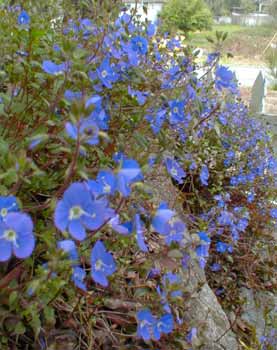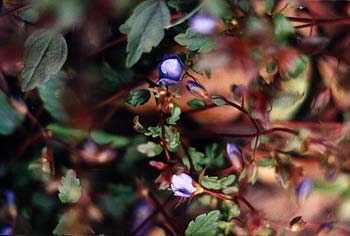 Creeping Veronica,
Creeping Veronica,
A Humble Splash of Blue
"The love of gardening is a seed
that once sown never dies."
Here's a flower that took me some while to find out what it was, just something that was already planted in a neglected corner of the yard long before we bought the house, & which was so hardy even neglect hadn't done it in. When I was building a cliff wall & changing that neglected corner dramatically, I was careful of the tiny vine as I didn't want to lose it. And in a short time with regular watering & care, it quite naturally flourished even more than when it was being overlooked.
With help from folks in a gardening newsgroup, I was able to focus in on what this tiny groundcover was, one of a group of flowers called "Speedwells," specifically Creeping Veronica. I slowly figured it out it was Veronica peduncularis -- rather, I thought I'd figured that out. After this page was up for over a year, I heard from Dr. Dirk Albach of the Botanisches Institut der Universitat Wien, who after looking closely at the photos of my Veronica informed me: "The Veronica that you call peduncularis is the same species I saw in Kew Gardens, so I know its story. In fact, it is Veronica umbrosa & its introducer misidentified it based on a misidentified specimen in the herbarium of Kew."
I had no doubt Dr. Albach identified this plant definitively, as he has done considerable research on speedwells, including at Kew Gardens, & his peer-reviewed articles include important work on Speedwell DNA. I wrote him back for clarification to be sure this also meant the only widely available cloned cultivar, sold under the name V. pedencularis "Georgia Blue" (aka "Oxford Blue" because originally gathered in the Russian Caucassus Mountains by an English horticulturist), was in fact a cultivar of V. umbrosa. The short answer is "Yes," but since this plant has been (up to 2004 as I ammend this page) universally cited by the wrong species name, the full reply seems significant enough to quote fully:
Dear Jessica: Yes, indeed, all Veronica peduncularis "Georgia Blue" are actually Veronica umbrosa because of this misidentification. I have heard that V. peduncularis is also available from some horticulturists. The difference between V. peduncularis & V. umbrosa are most obviously flower color. V. peduncularis is white with pinkish veins, whereas V. umbrosa is sky blue. Second, V. umbrosa occurs from the Crime peninsula to Abchasia in the western Caucasus (where Roy Lancaster collected it in 1979), whereas V. peduncularis occurs more east in the Greater Caucasus & down through the Lesser Caucasus into Turkey. Other differences include the reddish glabrous stem, the more narrow leaves, & the shorter pedicels of V. umbrosa. Thanks for correcting your webpage so rapidly and linking it to my homepage. --DirkNoodling around Dr. Albach's homepage, I saw that he linked my photograph to his vastly more sciency site; kind of cool that one of my garden photos was regarded as good enough to represent the species.
 It produces flowers singly on stems instead of spiked clusters like most speedwell species. Ours is doing well in a shady location, though it would likely do just as well in sun, & might even produce more flowers in a sunnier spot; I've never wanted to move it since it survived all those years right where it is when no one was taking care of the yard.
It produces flowers singly on stems instead of spiked clusters like most speedwell species. Ours is doing well in a shady location, though it would likely do just as well in sun, & might even produce more flowers in a sunnier spot; I've never wanted to move it since it survived all those years right where it is when no one was taking care of the yard.It does its main blooming in February through April with a peak in March (the first photo above was snapped March 2004). It has a second peak blooming in Autumn. But really it blooms for us year-round, even in the middle of summer it'll have at least a scattering of blossoms, & at intervals in the midst of winter it'll have a single unexpected bright blue four-petalled bloom. The deep green waxy serated leaves of summer turn bronzy in fall & nearly matches the red of the stems in winter. It never raises its semi-prostrate vines any higher than three or four inches.
It likes temperate weather & won't survive desert conditions or extreme cold. It's perfect for Puget Sound weather, but in regions below Zone 6, it would have to be practically buried in mulch to survive the winter, & would not bloom so early in the year. It does not spread rapidly & is at no risk of becoming weedy; I almost wish it were.